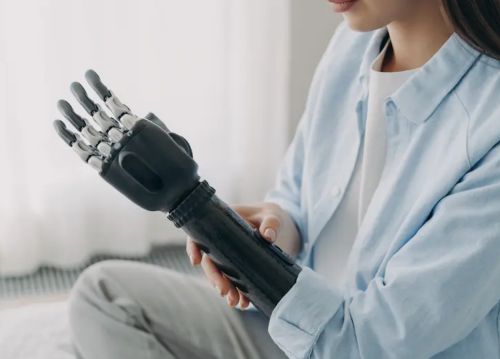

Losing an arm changes how a person lives, moves, and feels about themselves. Everyday tasks like eating, writing, or dressing become harder, and confidence can drop. However, modern medical technology has created new ways to help people live full lives again.
A shoulder disarticulation prosthesis gives people the chance to move more freely and do things on their own again. This article explains how these prosthetic devices work and what makes them special. It also explains how they help people regain control, comfort, and confidence in their daily lives.
Purpose of Shoulder-Level Prosthetic Design
When an arm is lost at the shoulder joint, there is no part of the limb left to attach a device easily. This makes the design more complex compared to other types of prosthetics. The main goal of a shoulder-level prosthetic is to replace the missing arm and bring back as much natural movement as possible.
Experts focus on three main goals while designing these devices:
- To restore balance and posture to the body.
- To help with natural arm and hand motion.
- To support strength for personal and work activities.
A properly fitted prosthetic helps the person feel complete again and boosts their confidence.
How Shoulder Disarticulation Devices Work
A shoulder-level prosthetic connects to the upper body using a custom-made socket. The socket covers part of the torso and must fit snugly while still being comfortable. Since there is no remaining upper arm, the socket supports the weight and function of the entire artificial arm.
These devices usually include:
- A shoulder joint for rotation and lifting.
- An elbow and wrist joint for bending and movement.
- A hand that can grip or hold objects.
Some prosthetics are mechanical and use cables to control movement. Others are electronic, using signals from the user’s muscles. In myoelectric systems, small sensors pick up electrical signals from the chest or shoulder muscles and turn them into movement. This allows smoother and more natural control.
Comfort and Proper Fit
The comfort of a prosthetic makes a big difference in how often a person wears it. If the device fits poorly, it can cause pain, pressure, or irritation. A skilled prosthetist designs the socket to spread weight and pressure evenly across the body.
Lightweight materials such as carbon fiber or flexible plastics make the device easier to wear. A comfortable fit helps the person use it longer each day and improves their quality of life. Comfort also builds trust in the device, which encourages daily use.
Control Systems That Help Users
Control systems determine how the person moves the prosthetic. There are two main types:
- Body-powered systems: These use cables and harnesses attached to the person’s shoulder or chest. When they move their body, the cables move the prosthetic. These systems are strong, simple, and require little maintenance.
- Myoelectric systems: These use muscle signals to move the artificial arm. They offer smoother control and look more natural. However, they need batteries and regular charging.
Each person’s lifestyle, activity level, and comfort determine which system suits them best.
Training and Rehabilitation
Using a shoulder-level prosthetic requires learning and practice. Physical therapists and occupational therapists play an important role in helping users adapt. They teach muscle control, balance, and coordination so the person can use the device effectively.
Training includes:
- Learning to control each joint step by step.
- Building muscle strength and stamina.
- Practicing everyday actions like holding, lifting, and reaching.
- Relearning how to use both sides of the body together.
The more consistent the practice, the smoother and easier the movements become. Rehabilitation builds both physical strength and mental confidence.
Comparing Other Prosthetic Solutions
Different kinds of artificial limbs support people based on how much of the limb they have lost. For instance, a finger prosthesis is created for someone who has lost part of a hand. It helps restore grip strength and allows them to hold and handle objects with better control. This type of device focuses on precision and improving small hand movements.
Another type, the ipop prosthesis (immediate postoperative prosthesis), is fitted soon after an amputation. It protects the healing area and helps patients start moving sooner, which supports faster recovery. Each device has its own purpose, but they all aim to bring comfort, function, and independence. Shoulder-level designs, however, remain the most complex and advanced because they replace the entire arm and shoulder functions.
Taking Care of the Device
A shoulder-level prosthetic needs regular care to stay in good condition. Proper maintenance prevents damage and keeps it comfortable to wear. Users should:
- Clean the socket and straps daily.
- Check cables, batteries, and moving parts.
- Visit the prosthetist for routine adjustments.
A clean and well-maintained device lasts longer and performs better. Regular checkups help avoid skin problems and mechanical issues.
Challenges and Patience
Adjusting to a prosthetic arm takes patience and commitment. The early stages can be tiring, and learning control can feel slow. However, progress comes with steady effort. Each small step, like lifting a cup or typing again, brings the person closer to full independence.
Determination is key. People who stay consistent in training and stay positive find great improvement in comfort and control over time. Support groups and therapy sessions can also help during this stage.
Restores Freedom and Independence
Being able to move freely again changes how a person lives. With a functional prosthetic, people can go back to work, enjoy hobbies, and take care of themselves. Simple acts like cooking or driving bring a sense of pride and confidence. Freedom from relying on others boosts self-esteem and happiness. It allows users to reconnect with the things they love and live more independently.
Long-Term Adaptation
As technology improves, prosthetic design keeps getting better. Over time, users learn new skills and find better ways to use their devices. Some even take part in sports or artistic activities that once felt impossible. Continuous updates in design and training mean users can enjoy better comfort, flexibility, and motion. The combination of personal effort and new technology keeps pushing the limits of what is possible.
A shoulder-level prosthetic gives people more than movement; it gives them hope, strength, and a chance to live life on their own terms. With the right training, care, and emotional support, these devices can make a lasting difference. They help individuals rebuild confidence, independence, and a sense of purpose. Mobility is not just about physical ability. It represents courage, determination, and the belief that life after limb loss can still be active, rewarding, and full of possibilities.


